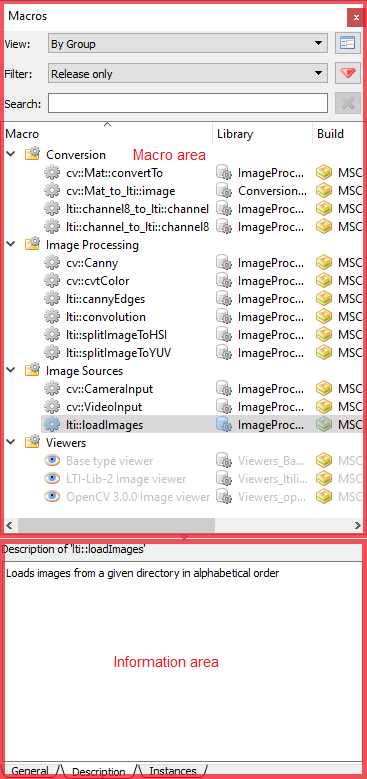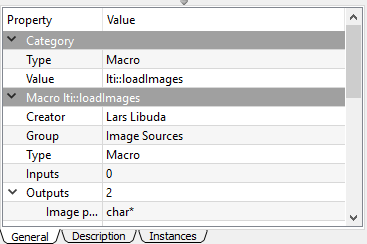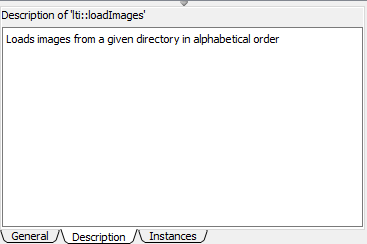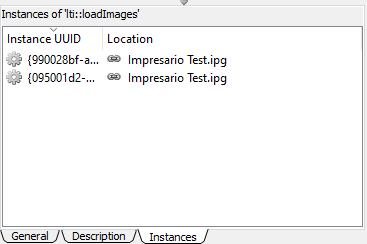Reference: Macro database window

Macro Database window overview (Click to enlarge)
The Macro database docking window contains all available macros. It is the most important docking window for creating and modifying process graphs. Therefore it can be customized to better suit your needs.
The window consists of two parts. The upper bigger part is the so called “Macro area", the lower part is the “Information area".
Macro area
The macro area is dominated by a tree view which visualizes all macros available for creating process graphs. Macros can be displayed in a tree structure or in a simple list including additional properties for structuring and sorting them. Sorting the database is possible by clicking a column’s header. The following item types with their corresponding icons can be displayed:
 Macro
is the macro itself identified by its name. It is the only mandatory item type to be displayed.
Macro
is the macro itself identified by its name. It is the only mandatory item type to be displayed.
 Macro library
denotes the library a macro belongs to. A macro library consists of one or more macro library files.
Macro library
denotes the library a macro belongs to. A macro library consists of one or more macro library files.
 Macro library file
is the physical file (.dll or .so) a macro is loaded from.
Macro library file
is the physical file (.dll or .so) a macro is loaded from.
 Macro group
shows each macro’s group. Macro developers can sort macros into groups for sorting
and structuring the database.
Macro group
shows each macro’s group. Macro developers can sort macros into groups for sorting
and structuring the database.
 Macro build
gives build information about each macro. The build information contains the
compiler name, compiler version, and the type of build (“Release” or “Debug”).
Macro build
gives build information about each macro. The build information contains the
compiler name, compiler version, and the type of build (“Release” or “Debug”).
 Macro creator
displays the name of a macro’s developer.
Macro creator
displays the name of a macro’s developer.
 Macro type
denotes each macro’s type. Currently the macro type has one of the following
values: “Macro” or “Viewer”. While the value “Macro” denotes a regular macro, “Viewer” is assigned to macros which visualize
data types exchanged between regular macros. These macros are handled differently and are called viewers.
Macro type
denotes each macro’s type. Currently the macro type has one of the following
values: “Macro” or “Viewer”. While the value “Macro” denotes a regular macro, “Viewer” is assigned to macros which visualize
data types exchanged between regular macros. These macros are handled differently and are called viewers.
 Viewer
is a special type of macro for visualizing data types exchanged by the regular macros. Viewers
are always shown in light gray color to indicate that they are listed for information purposes only.
In the settings dialog it is possible to disable the listing
of viewers in the database to avoid confusion.
Viewer
is a special type of macro for visualizing data types exchanged by the regular macros. Viewers
are always shown in light gray color to indicate that they are listed for information purposes only.
In the settings dialog it is possible to disable the listing
of viewers in the database to avoid confusion.
At the top of the macro area three controls are located which allow to layout and narrow down the number of macros displayed in the tree view.
View
The View combo box contains a list of available views which change the structure and type of information displayed in the tree
view containing the macros. Pressing the
 View
View
Filter
Filters can be used to only display macros which fulfil the criteria defined by the active filter. The filter combo box offers
all filters defined. It also contains the special filter “None” which actually switches off filtering. The list of filters can
be modified. The
 Filter
Filter
Search
Text entered into the search input box narrows down the number of macros in the tree view directly. The entered text is matched
against each macro’s name, starting from its beginning. The match is case insensitive. Only matching macros are shown in
the tree view and the first matching macro is highlighted. Pressing the “Enter” key in this situation adds one instance of the
highlighted macro to the top left corner of the current active process graph. The
 Reset
Reset
Information area
The information area displays more detailed information for each item type when selected in the tree view. Depending on the selected item type one to three different tabs with information are available. The settings dialog allows to configure the default tab for each item type.
General information tab

Tab for general item information (Click to enlarge)
General information are displayed for every item type but the most detailed information are available for  Macros
(see screenshot for an example),
Macros
(see screenshot for an example),  Macro library files
, and
Macro library files
, and  Viewers
. For the remaining types only
the item type and name are displayed.
Viewers
. For the remaining types only
the item type and name are displayed.
Description tab

Tab displaying item descriptions (Click to enlarge)
Descriptions are only available for item types  Macros
(see screenshot for an example),
Macros
(see screenshot for an example),  Macro library files
, and
Macro library files
, and  Viewers
.
However, the developer must have provided this information otherwise the tab will be empty.
Viewers
.
However, the developer must have provided this information otherwise the tab will be empty.
Instances tab

Tab showing macro instances (Click to enlarge)
The instances tab is only shown in case a  Macro
is selected. In this case this tab lists all currently
created instances of the selected macro. The list has two columns.
Macro
is selected. In this case this tab lists all currently
created instances of the selected macro. The list has two columns.
The column denoted “Instance UUID” contains the Universal Unique Identifier of an instance Impresario uses to identify the macro instances within the application.
The column with header “Location” shows the process graph’s name the macro instance is located in. The process graph name may be set to
“(Untitled)” in case the graph has just been created and never been saved to disk. Left to the location’s name an icon depicts a more
detailed status of each instance. The unbroken chain icon  means that the macro instance is an active part of the
process graph, the broken chain icon
means that the macro instance is an active part of the
process graph, the broken chain icon  denotes a macro instance which was removed from the process graph but is still
available for an
denotes a macro instance which was removed from the process graph but is still
available for an
 Undo
Undo
A right click on any row in the tab brings up a popup menu which allows you to navigate directly to the selected macro instance (for active instances) or at least to its process graph (for already removed instances).